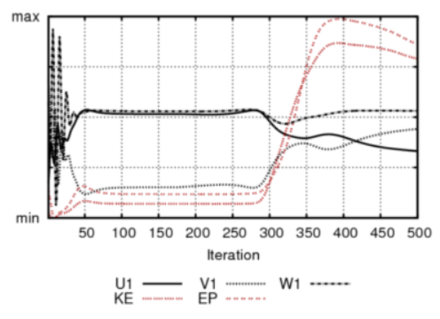For a typical classification of atmospheric stability, the table that circulates in the literature goes somethig along the lines of:
very unstable: -100 <= L <= -50
unstable: -200 <= L <= -100
near-unstable: -500 <= L <= -200
neutral: |L| > 500
near-stable: 200 <= L <= 500
stable: 50 <= L <= 200
very stable: 10 <= L <= 50
However, for a steady-state RANS solver like WindSim there are a few caveats.
We do not recommend running unstable cases as for such an atmosphere there are no physically meaningful solutions that would satisfy the steady-state NS equations. In practise convergence may be found, but the resulting wind fields rarely lead to improvements in simulation accuracy (cross-prediction errors). In many cases it may seem like a convergence has been achieved, but if you repeat the simulation with stricter convergence criteria, the simulations can almost out-of-the-blue transition to a new "equilibrium" (here's an example for L = -100 m):

Stable cases tend to be easier to converge - but only up to a point. MO length of about 50 meters is about the lower limit that should be used. Below that the turbulence parameterizations begin to show unrealistically low values of mixing and TKE, as the model does not take into account the sporadic and intermittent mixing that happens in a real boundary layer. This lack of mixing can also manifest in convergence issues of the turbulence variables.
Thus, in summary, the neutral, near-stable and stable cases should pose no problems for the solver.
